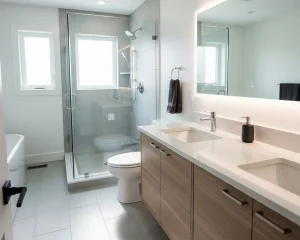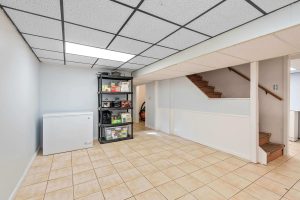Renovating a house is part design, part logistics, and part risk management. The work touches structure, plumbing, electrical systems, and building code requirements. Done well, a renovation enhances day-to-day life and maintains resale options. Done poorly, it becomes a source of stress and expense.
This article is written for Edmonton homeowners who want a clear, step-by-step approach to finding home renovation contractors who are familiar with local rules and know how to manage projects from permits through final sign-off. I’ll include real examples, local references, and trusted sources so you can act with confidence.
Why the right contractor matters in Edmonton
A renovation is a coordinated project involving multiple licensed trades, inspections, and, often, permits. In Edmonton, many interior upgrades require building or trade permits. Starting work without the right permits can lead to stop-work orders and fines, and it complicates resale or insurance claims. Use the City of Edmonton’s permit guidance to check what your project needs before you sign a contract. edmonton.ca
Good contractors bring four things you cannot buy on a spreadsheet: reliable sequencing, clear communication, licensed trade coordination, and proper documentation. Those qualities reduce risk and keep surprises to a minimum.
Where to start: search and shortlisting
Begin local and practical. Use these pathways.
- Ask neighbours and community groups for personal referrals. Local projects give you visible proof of work and real references.
- Look for contractors who have completed similar work in Edmonton neighbourhoods like Old Strathcona, Glenora or Mill Woods. Local experience matters because of older house assemblies and typical inspection expectations.
- Check online ratings and photos, but treat reviews as one part of your decision. Follow up on references and ask to visit a recent job if the homeowner agrees.
A short list of three vetted contractors gives you enough choice to compare without drowning in bids.
What to check before the first meeting
Before you invite contractors in, gather a simple packet for each: photos of the space, a brief project description, and a list of must-haves. This keeps the first meeting focused.
Questions to ask every candidate
- Have you completed similar projects in Edmonton? Can I see photos and speak to recent clients?
- Who will be my daily point of contact during the project?
- Who pulls permits and coordinates inspections? (Confirm whether the contractor or the homeowner will apply.)
- Which trades do you subcontract, and can you provide licences and insurance for them?
- How do you document changes and price them? What does a change order look like?
- What warranties do you offer on labour and installed systems?
A straightforward contractor gives clear answers and offers references without hesitation.
Vetting documents and credentials
A proper vetting process looks beyond price. Ask to see:
- Proof of business insurance and liability coverage.
- Copies of trade licences for electricians, plumbers, and HVAC techs that will work on your project.
- A sample contract showing scope, milestones, payment schedule, and change-order terms.
- Recent project references and photos.
- Evidence they have pulled permits for similar projects in Edmonton and have completed inspections.
If any of these items are missing or the contractor fumbles when asked, treat that as a warning sign.
Understanding permits and code context
Edmonton follows Alberta’s building code implementation. Alberta adopted the National Building Code – 2023 Alberta Edition, which affects renovation standards and safety requirements. A professional contractor should be familiar with the code edition that applies and the common permit triggers for home renovations. Ask contractors to explain which parts of your project will need permits and what the inspection checkpoints are. Alberta.ca
Permits protect you. They ensure work is inspected at key stages and that systems are safe. A contractor who asks about permits early is usually thinking like a professional.
How to compare proposals fairly
When you have written proposals from your shortlist, compare them line by line. A good comparison covers more than price.
- Scope and exclusions: Are all tasks listed with clear responsibilities?
- Trade coordination: Who manages subcontractors and inspections?
- Timeline and milestones: Are major stages and inspection points shown?
- Materials and allowances: Are product types specified, or are there vague allowances?
- Change-order procedure: Is it written and clear?
- Warranty and aftercare: What’s covered and for how long?
Pick the proposal that balances clarity with accountability. The cheapest quote can hide omitted items; the most expensive is not always best.
Communication, documentation, and project management
Projects stall when communications fail. Ask each contractor how they will keep you informed.
- Will they provide a weekly update?
- Will they document progress with photos and inspection records?
- Who is the on-site decision maker for trade issues?
- How will they record and approve change orders?
Insist on a written plan for communication. The contractor who can’t name a single communication tool or routine is likely to leave you guessing during the build.
Red flags to avoid
Avoid contractors who:
- Push you to skip permit requirements to save time. That’s a risk you do not want.
- Demand large, cash-only deposits or pressure you to sign without a written scope.
- Hesitate to provide references or certified trade licences.
- Refuse to show a sample contract or avoid a clear change-order process.
If anything about a contractor makes you uneasy, move on. Trust your instincts; they’re useful.
Real-world examples from Edmonton
Example 1: An older bungalow in Garneau needed a kitchen reconfiguration that affected a load-bearing wall. The homeowner shortlisted two contractors. One immediately suggested the structural change could be done without an engineer. The other arranged an engineer review, adjusted permit drawings, and coordinated an inspection. The first approach would likely have caused a stop-work order; the second delivered a compliant solution with documented approvals.
Example 2: A duplex in the west end required new plumbing and electrical work for a bathroom upgrade. The selected contractor provided a project folder with before-and-after photos and all inspection sign-offs. That documentation simplified a later sale and avoided questions at closing.
These examples show how diligence up front prevents bigger problems later.
Contracts, payment terms, and protecting yourself
A good contract protects both parties. Key items to include are:
- Detailed scope of work and a list of included materials.
- A project schedule with major milestones and acceptable delays.
- Clear change-order rules that require written homeowner approval.
- Details on who pulls permits and pays permit fees.
- Insurance, licence confirmations, and warranty statements.
- Final sign-off and snag list procedure.
Avoid vague language. If your contract reads like a handshake in print, ask for clarification.
Aftercare and warranties
A renovation does not end at final paint. Ask about warranty coverage and how the contractor handles defects that appear after completion. A reliable contractor will:
- Provide a written workmanship warranty.
- Supply manufacturer warranties for installed products and show you where to register them.
- Offer a documented snag-list process and complete outstanding items within an agreed timeframe.
Keep the final project folder with all permits and warranties. It’s valuable for future maintenance and resale.
Market context and practical planning
Renovation costs and contractor availability are influenced by local and national trends. Statistics Canada’s Residential Renovation Price Index tracks contractor pricing trends and shows recent quarterly increases across provinces, including Alberta. Expect that contractor schedules and material lead times reflect these market trends, so plan accordingly and allow time for product selection and permit review. Statistics Canada
City and national housing reports also show policy shifts that encourage in-place improvements like secondary suites and missing middle housing. Contractors who understand these trends can suggest practical design and permit strategies that align with municipal priorities. cmhc-schl.gc.ca
How Steadfast Constructions Ltd. helps Edmonton homeowners
Steadfast Constructions Ltd. is a local firm that focuses on end-to-end renovations across Edmonton. Their services help reduce the common friction points homeowners face:
- A pre-construction review to flag permit triggers and hidden conditions.
- Permit coordination and permit-ready drawings so inspections proceed smoothly.
- Coordination of licensed trades and staged inspections to avoid rework.
- Clear documentation and a final project folder with inspection sign-offs and warranties.
If you prefer to hand the project management to a single, accountable team, Steadfast offers a straightforward, code-first approach designed for Edmonton homes. Visit their services page to see examples and to request a site review:
Conclusion
Choosing Home Renovation Contractors is more than a price decision. It is about finding a team that understands Edmonton permits and the Alberta building code, coordinates licensed trades, communicates clearly, and documents every step. Start local, ask the right questions, insist on a written scope and permits, and keep a project folder with all contracts and inspection records.
If you want a low-hassle route, Steadfast Constructions Ltd. offers site reviews, permit coordination, trade management, and a documented handover. Contact Steadfast Constructions Ltd. to schedule a feasibility review and get a clear plan that protects your home and your time.
Frequently Asked Questions (FAQs)
Q1: What should I ask Home Renovation Contractors before hiring them?
A1: Ask about recent Edmonton projects, who will be your daily contact, whether they handle permits and inspections, which trades they subcontract, how they manage change orders, and what warranties they provide.
Q2: Do I need permits for a home renovation in Edmonton?
A2: Many renovations require permits, especially when plumbing, electrical, gas, or structural work is affected. Check the City of Edmonton’s residential permit guidance and confirm with your contractor who will apply and schedule inspections.
Q3: How can I verify a contractor’s credentials?
A3: Request proof of business insurance, licences for subcontracted trades, references from recent local jobs, and examples of completed work. Verify that the contractor has experience with Edmonton inspections and permits.
Q4: What red flags should I watch for when hiring a contractor?
A4: Red flags include pressure to skip permits, refusal to provide references or licences, cash-only large deposits, and vague contracts. Walk away if a contractor is evasive.
Q5: How important is documentation after the renovation?
A5: Very important. Keep the contract, permits, inspection reports, product manuals, and warranty documents. This folder protects you in the event of defects, insurance claims, or home resale.







